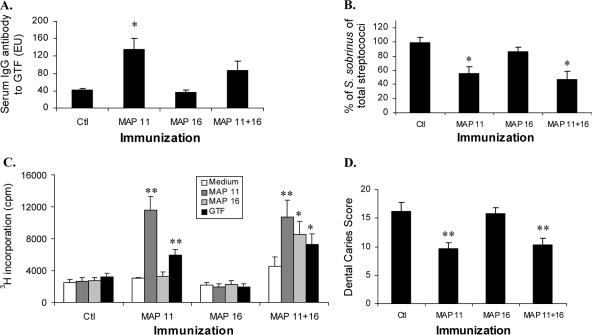FIG. 4.
Immune response to MAP constructs and pathogenesis of dental caries (pathogenesis experiment 1). Rats (8 to 11/group) injected with buffer (control [Ctl]) or MAP construct 11, 16, or 11 plus 16 were infected with S. sobrinus for 38 days. (A) Serum IgG antibody (ELISA units [EU]) at termination boost is shown as bars depicting group mean and standard errors. *, different from control and MAP 16-immunized animal groups by SNK multiple comparison test; statistically significant, P < 0.05. (B) Recovery of S. sobrinus as mean percentage of total streptococci 13 days after infection, shown as bars and standard errors. Geometric mean recoveries of S. sobrinus ranged from 1.8 × 105 to 6.0 × 105 per swab. *, differences when all groups are compared by SNK, statistically significant; P < 0.05. (C) Rat cervical lymph node cells (at termination) were cultured in triplicate in the presence and absence of MAP constructs or native GTF. [3H]thymidine (0.5 μCi/well) was added for the last 16 h of culture. Radioactivity is expressed as counts/minute (cpm). Group means are indicated by bars and standard errors. *, P < 0.05; **, P < 0.01 (differences between groups statistically significant) when analyzed by SNK. (D) Bars show the mean total caries scores, including smooth and sulcal surfaces, and standard errors for 8 to 11 rats per group. **, differences among groups compared by SNK, statistically significant; P < 0.01.

